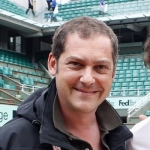Taking the time
Jerusalem -- If you want to know people’s secrets, you need time. You can’t just show up, snap some pictures for a few days and expect that people will open up to you. Especially if they are the guardians of the Tomb of Christ who have been in the Old City of Jerusalem for the last 800 years, the Christian group with the longest continuous presence in the Holy City.
 Franciscan friars pray and sing during the Lenten procession around the Tomb believed to the be site where Jesus Christ is buried in the Church of the Holy Sepulchre in the Old City of Jerusalem, on February 17, 2018.
(AFP / Thomas Coex)
Franciscan friars pray and sing during the Lenten procession around the Tomb believed to the be site where Jesus Christ is buried in the Church of the Holy Sepulchre in the Old City of Jerusalem, on February 17, 2018.
(AFP / Thomas Coex)As a news agency photographer, you don’t usually have the luxury of spending lots of time on one story. You usually go in, cover what needs to be covered and move on. Especially at a busy place like the Jerusalem bureau. I’ve been with AFP for 30 years and this is the first time that I got to spend weeks on a single story.
The idea came one day as I was walking the streets of the Old City of Jerusalem last October. I’ve been the chief photographer for Israel and the Palestinian Territories for four years and when I can, I regularly go to the Old City. The winding streets always make for good features.
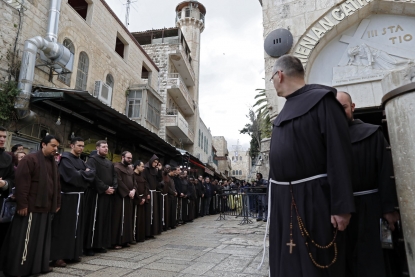 Franciscan friars pray at the 3rd Station on the Via Dolorosa (Way of Suffering) in the Old City of Jerusalem during the weekly Friday procession on February 23, 2018.
(AFP / Thomas Coex)
Franciscan friars pray at the 3rd Station on the Via Dolorosa (Way of Suffering) in the Old City of Jerusalem during the weekly Friday procession on February 23, 2018.
(AFP / Thomas Coex)On this day, I was snapping pictures of tourists on Via Dolorosa when I saw a group of several dozen people all wearing the same T-shirt that said 800 years on it. Intrigued, I asked them what that was about. They told me they were marking 800 years since Franciscans, a group of related orders within the Catholic Church, first came to the Holy City.
Franciscans are today a group of orders within the Catholic Church and they are one of the three churches who are the guardians of the Tomb of Christ. The tomb is the place that Christians believe Jesus was buried for three days before he was raised from the dead. Most Christians believe this place to be a tiny grotto in the Church of the Holy Sepulchre in Jerusalem.
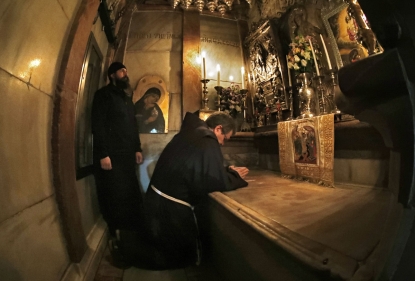 Franciscan Custos Father Francesco Patton (C) and friars pray inside the Tomb of Christ on February 23, 2018.
(AFP / Thomas Coex)
Franciscan Custos Father Francesco Patton (C) and friars pray inside the Tomb of Christ on February 23, 2018.
(AFP / Thomas Coex)Intrigued, I approached the Franciscans with a request to do an in-depth feature on them. They were hesitant at first. They are quite private and when I told them that I wanted to shoot beyond what most people usually see, to document scenes from their daily lives, they didn’t answer. But then I was at a party and learned that my friend Cyrille Louis from Le Figaro Magazine had the same idea. We decided to combine forces and after some gentle persuasion, the friars finally agreed.
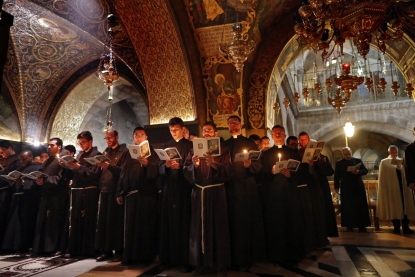 Franciscan friars pray and sing during the Lenten procession inside the Church of the Holy Sepulchre in the Old City of Jerusalem, on February 17, 2018.
(AFP / Thomas Coex)
Franciscan friars pray and sing during the Lenten procession inside the Church of the Holy Sepulchre in the Old City of Jerusalem, on February 17, 2018.
(AFP / Thomas Coex)I spent two and a half months on the story, shooting whenever my busy schedule allowed it. When you do a story like this -- when you try to get a real feel for you subject, to go beyond the surface -- confidence is key.
You need to have their confidence. I came many times just to talk, with my camera, but without taking a shot. The Franciscans saw me many, many times and with time they just got used to me and I got glimpses of things only they see.
As a result, I got some fantastic material and I think I managed to convey a nice, textured portrayal of the Franciscans.
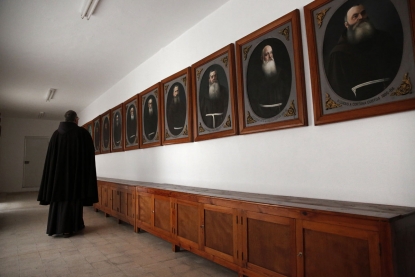 A Franciscan friar walks past the portraits of former Custos placed in a dedicated room at the St Saviour Monastery, the Franciscan headquarters in the Old City of Jerusalem, on January 25, 2018.
(AFP / Thomas Coex)
A Franciscan friar walks past the portraits of former Custos placed in a dedicated room at the St Saviour Monastery, the Franciscan headquarters in the Old City of Jerusalem, on January 25, 2018.
(AFP / Thomas Coex)In Jerusalem the group is divided into two parts. There is a group of 15 friars that lives in the Holy Sepulchre, which takes care of the tomb, leads prayers and processions. They are the ones that most tourists will see when visiting the church.
Visitors to the Holy Sepulchre see but a section of the space allocated to the Franciscans. They have their sleeping quarters, a kitchen, a meeting room, and sacristy. The main function of the friars of the church are the prayers, the processions and the welcoming of worshippers. And of course taking turns with the Greek Orthodox and the Armenians in taking care of the tomb.
That’s where the time spent gaining trust also paid off. Visitors to the Holy Sepulchre know -- to see the tomb, you usually stand in line for more than an hour, to spend less than a minute inside. I got to be inside for an hour and a half while it was cleaned. That doesn’t happen very often.
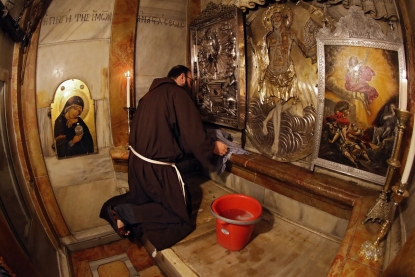 Croatian friar Sinisa Srebrerovic cleans the ornaments inside a tomb believed to the burial site of Jesus Christ on March 2, 2018.
(AFP / Thomas Coex)
Croatian friar Sinisa Srebrerovic cleans the ornaments inside a tomb believed to the burial site of Jesus Christ on March 2, 2018.
(AFP / Thomas Coex)Aside from the Franciscans in the church, there are about 80 friars who live in a convent 200 meters away from the church. They pray as well, but they also perform a lot of social activities. The convent is the headquarters of Franciscans in the Holy Land. From here, they manage the various holy places where they have a presence in Bethlehem, Nazareth, but also in Lebanon, Syria, Iraq, Cyprus and the island of Rhodes. They manage some 1,200 employees in the entire Holy Land.
The convent is huge. Like everything in the city, it’s very old, has lots of floors and there is lots of activity. You have friars working in the garden, where they have grown medicinal herbs for centuries (unfortunately since I worked during the winter, I didn’t get any shots of this). You have friars baking bread in the bakery, friars smoking porc from the swine that they buy from a kibbutz; a tailor making the brown robes that they wear. It’s basically a small city inside.
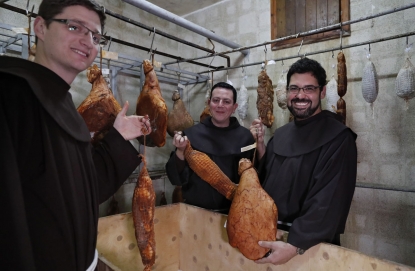 Franciscan friars show hams and sausages they produce for their consumption, at an underground basement at the Saint Saviour Convent, the Franciscan headquarters in the Old City of Jerusalem, on March 14, 2018.
(AFP / Thomas Coex)
Franciscan friars show hams and sausages they produce for their consumption, at an underground basement at the Saint Saviour Convent, the Franciscan headquarters in the Old City of Jerusalem, on March 14, 2018.
(AFP / Thomas Coex)You have friars who are in charge of the archives. This is the most important and secure place in the convent, because it contains some priceless documents, some dating to the 13th century, like, the agreement from the Mamluks, who were then in charge, that the Franciscans could remain in Jerusalem. There is also a sword from the 13th century that’s used to knight the knights of the Holy Sepulchre.
 Franciscan friar Sergei Loktionov shows a firman, a royal mandate issued by the Ottoman Empire's Sultan Othman Khan III in 1757, which authorised the Franciscans to pray at the Jesus' Tomb, and the Cavalry and on the Anointing Stone, at the Saint Saviour Convent, the headquarters of the Franciscans in the Old City of Jerusalem, on January 25, 2018.
(AFP / Thomas Coex)
Franciscan friar Sergei Loktionov shows a firman, a royal mandate issued by the Ottoman Empire's Sultan Othman Khan III in 1757, which authorised the Franciscans to pray at the Jesus' Tomb, and the Cavalry and on the Anointing Stone, at the Saint Saviour Convent, the headquarters of the Franciscans in the Old City of Jerusalem, on January 25, 2018.
(AFP / Thomas Coex)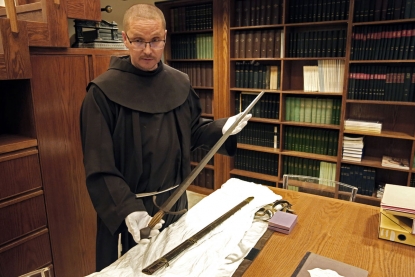 Franciscan friar Sergei Loktionov shows the sword used since the XIII century by the Custos (the chiefs of the Franciscans in the Holy Land) to anoint knights of the Holy Sepulchre.
(AFP / Thomas Coex)
Franciscan friar Sergei Loktionov shows the sword used since the XIII century by the Custos (the chiefs of the Franciscans in the Holy Land) to anoint knights of the Holy Sepulchre.
(AFP / Thomas Coex)
The friars keep themselves busy. They own around 400 apartments in the Old City and are in charge of renovating them and keeping track of the upkeep. They use the apartment to keep a presence of Christians in the Old City, so they let people live in them basically rent-free, just paying the city taxes.
Spending so much time with them meant that I got access to thing that no journalists have ever had before and having fantastic shots.
Like the nice shots I had of the friars playing sports with students at the Terra Sancta school in the Old City.
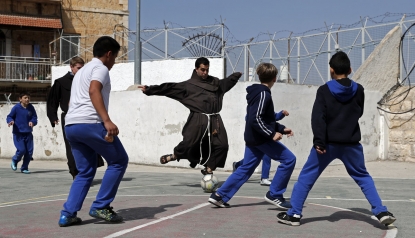 A Franciscan friar plays football with Palestinian children from the Terra Sancta school during a sport session in the Old City of Jerusalem, on March 1, 2018.
(AFP / Thomas Coex)
A Franciscan friar plays football with Palestinian children from the Terra Sancta school during a sport session in the Old City of Jerusalem, on March 1, 2018.
(AFP / Thomas Coex)Or the shots of retired friars who live in the infirmary on the last floor of the convent, spending the last moments of their life so that they could die close to Jesus’s tomb.
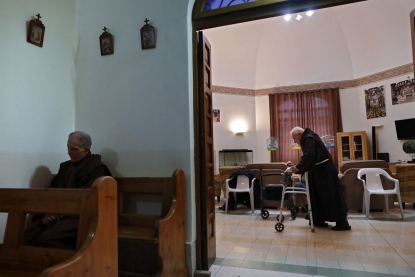 Franciscan friars, who are retired or on sick leave, are seen at the infirmary, a whole floor dedicated to them, at the Church of the Saint Saviour Convent, headquarter of the Franciscans in the Holy Land, in the Old City of Jerusalem, on February 11, 2018.
(AFP / Thomas Coex)
Franciscan friars, who are retired or on sick leave, are seen at the infirmary, a whole floor dedicated to them, at the Church of the Saint Saviour Convent, headquarter of the Franciscans in the Holy Land, in the Old City of Jerusalem, on February 11, 2018.
(AFP / Thomas Coex)Or the shots of them visiting people living in the Old City who are too infirm to go to the Church to receive communion.
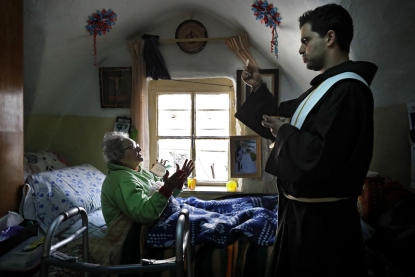 Franciscan friar Ayman Bathesh (R) gives communion to an elderly ill Christian woman at her home in the Old City of Jerusalem, on February 12, 2018.
(AFP / Thomas Coex)
Franciscan friar Ayman Bathesh (R) gives communion to an elderly ill Christian woman at her home in the Old City of Jerusalem, on February 12, 2018.
(AFP / Thomas Coex)There were also the natural, unguarded moments of daily life. After lunch and dinner, most of the friars go to a large lounge, where they can have a coffee, play cards, chat. It’s a very nice atmosphere and it’s a side of them that you wouldn’t otherwise see.
 Franciscan friars play cards during a coffee break after lunch at the Saint Saviour Convent, the Franciscan headquarters in the Middle East, in the Old City of Jerusalem, on March 16, 2018.
(AFP / Thomas Coex)
Franciscan friars play cards during a coffee break after lunch at the Saint Saviour Convent, the Franciscan headquarters in the Middle East, in the Old City of Jerusalem, on March 16, 2018.
(AFP / Thomas Coex)Or right before the meal, when they pray. No-one could take a picture of this moment before me.
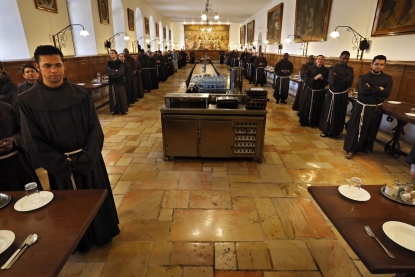 Franciscan friars pray before having dinner at the refectory inside the Saint Saviour Convent, the Franciscan headquarters in the Old City of Jerusalem, on March 15, 2018.
(AFP / Thomas Coex)
Franciscan friars pray before having dinner at the refectory inside the Saint Saviour Convent, the Franciscan headquarters in the Old City of Jerusalem, on March 15, 2018.
(AFP / Thomas Coex)This was one of my favorite assignments. I ended up having incredible access. Who but the friars has spent an hour and a half in the Tomb of Christ? Or seen how the Franciscans play basketball with children at their school? Or how they relax after lunch? You need time to get shots like this. Lots of time.
This blog was written with Yana Dlugy in Paris.
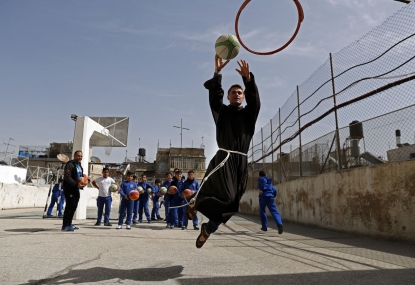 A Franciscan friar plays basketball with Palestinian children from the Terra Sancta school during a sport session in the Old City of Jerusalem, on March 1, 2018.
(AFP / Thomas Coex)
A Franciscan friar plays basketball with Palestinian children from the Terra Sancta school during a sport session in the Old City of Jerusalem, on March 1, 2018.
(AFP / Thomas Coex)


